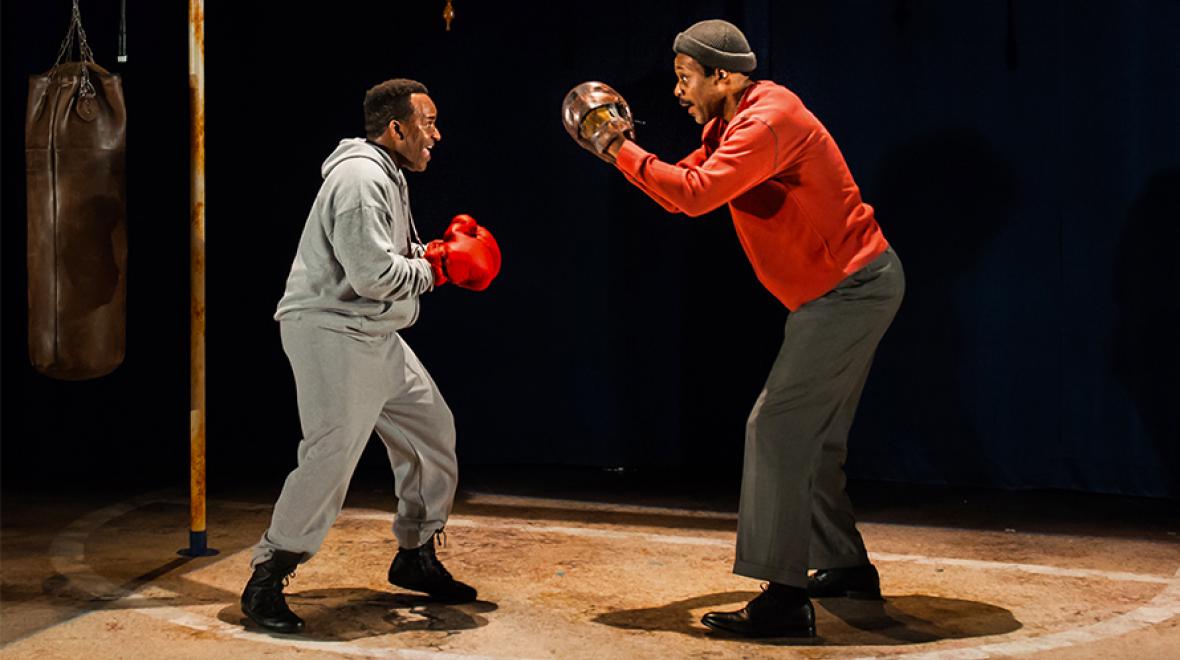
Photo:
“And In This Corner: Cassius Clay” plays at Seattle Children’s Theatre through Nov. 25. Photo credit: Elise Bakketun
The bottom line
“And In This Corner: Cassius Clay,” a play about the early life of boxer and activist Muhammad Ali, is on stage at Seattle Children’s Theatre through Nov. 25.
The story follows Cassius Clay, who changed his name to Muhammad Ali in 1964, from when he first learned to box at age 12, through his triumph at the 1960 Olympics at age 18.
Interwoven with his story are examples of racism and violence in the United States. Because of these troubling and complex issues, the show is recommended for ages 9 and up.
Stage notes
The show starts with 12-year-old Cassius Clay portrayed as just another kid growing up in 1950s America. Next, Clay and his brother Rudy go out shopping with their mom.
They get thirsty and ask to go into a nearby diner for a drink of water only to have their mom explain that the restaurant is "whites only." Up until this moment, the story felt lighthearted and funny, making this turn particularly jarring.
The tagline for the show says it all: "No matter how big they got, they started out small." From early on in the show, greatness shines in young Clay. He trains hard in the ring and is eventually asked to box on the television program "Tomorrow’s Champions."
He jokes about being “a smart and handsome young man” and tells everyone that he's going to be a hero — even though his friends remind him that there are no comic book heroes of color.
There is no realistic boxing in the play; rather, the fights are narrated by a ringside announcer as they happen off stage. The set is sparse, with signs indicating buildings and a moveable diner counter — giving the actors plenty of space to move around and even ride bikes.
Adult actors André G. Brown (Cassius Clay) and Chip Sherman (Rudy Clay) portray the Clay brothers with childlike glee and deft physical comedy. Both actors realistically react to the harsh realities of racial segregation and violence that their characters face.
In one scene, Cassius and his friends learn of the 1955 murder of Emmett Till, a 14-year-old boy in Mississippi. The friends try to process the murder of a black boy — who is "just like them" — for allegedly harassing a white woman.
The horrific crime prompts Cassius' friend Eddie to join peaceful protests calling for civil rights, but Cassius instead chooses to focus on his training. This causes strain in their friendship. (The murder of Till, which The New York Times called "among the starkest and most searing examples of racial violence in the South," remains in the news in 2018.)
Flash-forward several years and an 18-year-old Cassius Clay wins gold at the 1960 Olympics. He's on top of the world, only to return home to the harsh reality of segregation, illustrated on stage when the newly crowned Olympian is refused service in a "whites-only" diner.
This experience inspires Clay to fight for civil rights, both inside and outside of the ring.
Parents should know
I took my 11-year-old, sixth-grade son to the play. We were both deeply affected by the story of Emmett Till's murder. My son became quite upset.
To be clear, the infamously grotesque lynching of Till is not shown or acted out; a character reads from a newspaper article of the event.
After the show, my son told me that although he had learned about segregation and the civil rights movement in school, he hadn’t heard specific stories of lynchings.
These difficult topics are well-handled by the actors. The writing of playwright and National Endowment for the Arts award-winner Idris Goodwin particularly shines through. We see life through the eyes of Clay.
Personally, I'm glad that my son and I saw the play together. It inspired great conversation. We discussed what he thought about Clay initially not joining in civil rights protests, and what we would have done in a similar situation.
We also discussed how racism still exists in the U.S., and how Clay showed perseverance in his training and in earning his high school diploma, despite learning disabilities. We also read more about Clay's later life and activism as Muhammad Ali.
The overall message of the play is to believe in yourself and fight for what is right — that's a good message for any time.
Tips
Before you go, it's a good idea to talk with your child about what they know of segregation and the civil rights movement, and to note that there is one use of a racial slur onstage.
The program for the show also has great material. One of Ali’s poems is printed with room below for kids to write their own poem. There's also a “What’s in a name?” questionnaire, which asks kids about their own name and explains why Clay changed his.
As always with SCT, the actors participate in a Q&A after the performance. They also often sign autographs, so bring your Sharpie.
Definitely allow time to have a conversation with your kids after this deeply affecting and important play.
If you go…When: "And In This Corner: Cassius Clay" is playing now through Nov. 25. Where: Seattle Children's Theatre at Seattle Center, 201 Thomas St., Seattle Cost: Tickets start at $20 and vary by performance. Check the website for periodic accessible performances, and check out discounted tickets for seniors, students and other groups. Buy online. Parking: Try street parking or one of the surface lots in the neighborhood, or take transit to Seattle Center. Tips: Download the Active Audience Guide for kids' activities connected to the play. And plan to stay for the cast Q&A. It will help your child debrief some of the more challenging aspects of the play. Nearby fun: Check out ParentMap’s guide to Seattle Center and don't miss the fantastic Artists at Play playground on the east side of the Armory. |











